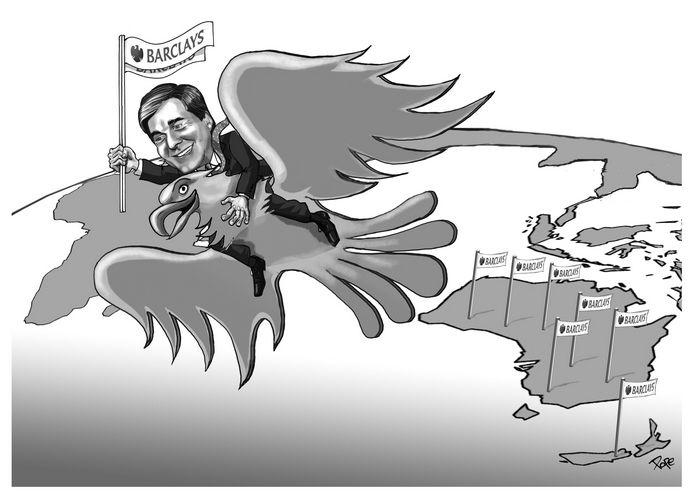Breaking from the pack: The European covered bond market was not as dominant in 2012 which allowed new issuers to step in and sell the product to supply-starved investors in new jurisdictions. For its ability to navigate the global market and display a comprehensive understanding of the changing needs of issuers, Barclays is IFR’s Covered Bond House of the Year.
To see the full digital edition of the IFR Review of the Year, please <a href="http://edition.pagesuite-professional.co.uk//launch.aspx?eid=24f9e7f4-9d79-4e69-a475-1a3b43fb8580" onclick="window.open(this.href);return false;" onkeypress="window.open(this.href);return false;">click here</a>.
Barclays has long been a leading player in the covered bond market. But 2012 was the year that the UK bank stormed ahead of its rivals, building new relationships in burgeoning markets while developing and maintaining its presence in its home market.
There is no doubt that 2012 was an unusual year for secured bank funding. The dominance of covered bonds and record issuance of the past were gone as primary supply plummeted following the ECB’s twin LTROs and the opening up of the senior unsecured market.
Barclays was quick to adapt to this new setting and took the opportunity to offer clients an unbiased approach to the global market. It carefully assessed the needs of a growing pool of clients that were eager to use their collateral to back deals in new currencies at the most economic levels.
“This is the year the covered bond market really transformed,” said David Kim, head of covered bond structuring at Barclays. “Euro issuance declined dramatically which allowed other countries and currencies to mature and grow.”
The figures are impressive. In the awards period, Barclays was responsible for some 9.4% of issuance in a market that totalled US$229bn in all currencies, according to Thomson Reuters data. And when it comes to trickier jumbo deals, it can claim nearly 11% of the US$116bn total – with 16 more transactions than its nearest rival.
Big down under
But it wasn’t just about league tables. One of the bank’s greatest achievements is the mark it has left on the Australian covered bond market.
Since the Australian government relented and allowed the country’s banks to use this new funding source, Barclays has been a leader in assisting banks that were eager to diversify their funding.
Australian and New Zealand banks sold a total of US$37bn-equivalent of covered bonds to global investors in the awards period, according to Thomson Reuters. The bank was the arranger of six of the nine covered bond programmes that were established in the jurisdictions, with league table credit of US$3.3bn for an 8.8% market share.
Highlighting its truly global abilities, Barclays helped Commonwealth Bank of Australia sell NKr750m (US$132m) of 10-year debt in April of this year, following up on a sterling floating-rate debut from National Australia Bank.
“By meeting with issuers and investors over the course of the year we were able to see that tastes were changing and that has helped our global business,” said Ted Lord, head of European covered bonds at Barclays.
But Barclays was not only a partner to the biggest names in Australia. It also offered sound advice and a safe pair of hands to regional player SunCorp Metway.
SunCorp sold the first covered bond from a non-major Australian bank, pricing a hefty A$1.6bn dual-tranche transaction that underlined the benefits of the covered bond product.
The transaction was viewed as a milestone in Australia as critics of the product had long argued that covered bonds would only be available to the biggest players. The deal also offered a template to regional US banks that may seek to use the product if legislation is passed in that country.
In the US market, Barclays expanded its presence by continuing to innovate, as can be seen from its role in two of the most notable transactions of the year. The bank first helped Stadshypotek sell a seven-year offering in September which was the longest-dated dollar-denominated covered bond since 2007.
The deal was so significant that it is expected to revive and bolster lobbying efforts in Washington to get US covered bond legislation back on the agenda.
More recently, Barclays helped Nord/LB become the first German issuer to test a Pfandbrief in the US covered bond market since 2006. The borrower sold a US$1bn three-year offering at 50bp over mid-swaps, a deal that was lauded as a significant achievement for the leads as Nord/LB had been waiting for a year to access the market.
Balancing act
Barclays may have seized opportunities outside of Europe for much of the year but that did not adversely affect its relationships in the home market. The UK bank is viewed by many issuers as the ideal partner in helping them access euro and sterling funding.
One of the most notable euro covered bond transactions this year came in February, when Barclays helped Santander attract the largest order book of the year for what was the first Spanish covered bond to be sold in over eight months.
Embattled Spanish banks had struggled to fund in the public market since the previous summer as investors shunned banks with exposure to peripheral sovereigns. That raised the pressure on Santander to complete a flawless deal.
Barclays took a careful read of the market to know that Santander would be able to achieve a €2bn size on the back of a whopping €8.25bn order book with 275 accounts participating.
The attractive pricing of mid-swaps plus 210bp, some 20bp tighter than initial guidance, was regarded as an important achievement for the issuer – Santander’s prior covered bond deal in 2011 had struggled.
Barclays also adapted to the needs of issuers in some of Europe’s strongest jurisdictions.
Early in the year, it helped Nordea Bank Finland price the largest ever Nordic covered bond – a €2.25bn five-year Finnish covered bond at mid-swaps plus 65bp, attracting €3.1bn of orders from 144 accounts through Barclays Capital, Bank of America Merrill Lynch, Nordea, RBS and UniCredit.
Barclays realised that borrowers could forgo new issue premiums as investors were desperate to buy any paper available. In Germany, it was one of the first banks to recognise the growing bid for German debt and helped Deutsche Hypothekenbank sell a €500m five-year 1.25% at mid-swaps plus 9bp in June that offered almost no new issue premium to underlying secondaries.
And as volatility sent waves of panic through the market, the team at Barclays maintained a level head. On one occasion in the summer, the bank helped Dutch state-owned bank ABN AMRO garner a €4.3bn order book from more than 170 investors for an opportunistic €1.5bn seven-year covered offering. That deal came less than 24 hours after a series of unexpected sovereign downgrades in Europe’s core.
The sheer power of Barclays’ franchise has been noticed by almost all of its competitors. Throughout the course of the IFR awards process, bankers from rival houses were quick to name Barclays as their main competitor.
“Barclays is a very big name in the market and for that reason there are certain issuers that won’t do a deal without them,” said one covered bond banker.
This kind of praise is rare in the competitive investment banking world and is a testament to the Barclays team. The bank has emerged from 2012 as a house that continues to win mandate after mandate by offering sound advice to clients on how to adapt to an often volatile market.



